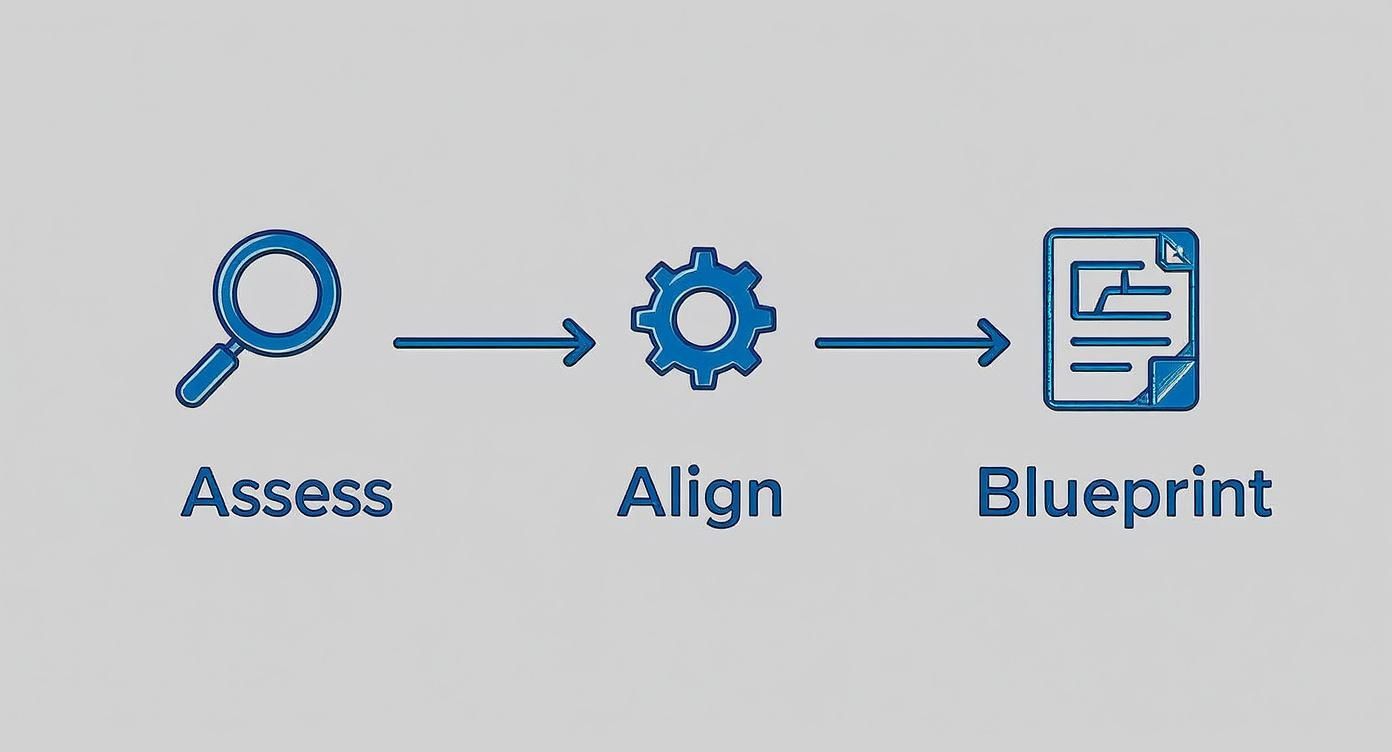Choosing an AI Tool for Ecommerce
Diving headfirst into the market for an AI tool for ecommerce without a solid plan is a fast track to wasting time and money. Before you even start looking at vendors, your first move should be to pinpoint the exact business problems you’re trying to solve.
This initial groundwork to accelerate digital retail is what turns a vague interest in “AI” into a rock-solid business case.
Defining Your AI Needs Before You Shop
You can’t pick the right tool until you truly understand the problem. Every single successful AI project I’ve seen starts with a crystal-clear business goal.
Are you wrestling with sky-high cart abandonment rates? Maybe customers are struggling to find what they want on your site. Or perhaps your one-size-fits-all pricing strategy is leaving money on the table. Nailing down these answers from the get-go makes your entire selection process focused and effective.
This discovery phase is all about looking inward. It’s time for an honest look at your current operations, the quality of your data, your team’s skills, and what you can realistically spend. This isn’t a test you need to ace; it’s about making sure your AI ambitions are grounded in reality, as we explored in our AI readiness guide.
Conducting a Practical Readiness Assessment
A good, hard look at where you stand today keeps your strategy tethered to what’s actually possible.
Start with your data infrastructure. AI tools are hungry for data, and the quality and accessibility of that data are everything. It’s a simple truth: bad data in, bad results out, no matter how sophisticated the tool.
Next, take stock of your team’s abilities. Do you have people in-house who can manage an AI system and make sense of its outputs? If not, you’ll need to budget for training or find external help. Looking into professional ai development services can shed light on the specific skills you might be missing.
Finally, set a realistic budget. Remember to think beyond the sticker price. Your budget needs to cover the software license, sure, but also the costs of integration, training, and ongoing maintenance.
A well-defined blueprint of what a successful AI tool looks like for your business is the most critical asset you can have. It keeps you from getting distracted by flashy features that don’t actually solve your core problems.
This simple workflow breaks down how to get that clarity.

You start by assessing your current challenges, then align potential solutions with your business goals, and finally, create a detailed blueprint for implementation. By taking this structured approach, you build a strong foundation that makes every other decision—from picking a vendor to rolling out the tool—so much easier.
It’s how you ensure you’re investing in a solution that delivers real, measurable value, not just the latest tech trend.
Should You Build or Buy Your AI Solution?

Alright, you’ve pinpointed the problems you want to solve with AI. Now you’ve hit a classic fork in the road: do you subscribe to an existing AI tool for ecommerce, or do you roll up your sleeves and build one from the ground up? This is a huge decision, and it’s about more than just technology—it’s about strategy, money, and your long-term place in the market. Explore a really useful customizable AI customer service assistant that seamlessly connects your business with customers using natural, intelligent, and lightning-fast conversations
Buying a pre-built SaaS software or tool is tempting for a reason: speed. You can get a solid solution live in weeks, not months or years. This is a massive win if you’re under pressure to boost conversions or cut fraud now. The costs are also predictable, a straightforward monthly fee makes the finance team happy.
But that speed comes at a price. You’re essentially renting, not owning. The vendor’s product roadmap dictates your future features, and it might not align with what your customers actually need. Customization is often superficial, and you might have to hand over your most valuable asset – your customer data – to a third party.
The Case For Building a Custom Solution
Going the custom route, either with your in-house team or a custom software development partner, puts you in the driver’s seat. You get to build something that fits your business like a glove, perfectly tailored to your unique workflows and data.
A custom AI tool is more than just software; it’s a competitive moat. It’s a proprietary asset your rivals can’t just go out and buy. It allows for seamless integration with your existing tech stack and gives you full ownership and control over your data and the insights it generates. Working with a dedicated provider of AI development services is often the key to creating this kind of lasting advantage.
The right decision boils down to your strategic priorities. Are you looking for a quick win with immediate cost efficiency? Or are you playing the long game, building a unique capability that your competition can’t replicate?
Deciding between building a custom AI platform and buying an off-the-shelf tool requires a careful look at your resources, goals, and competitive landscape. I’ve put together a table to help you weigh the pros and cons of each approach side-by-side.
Build vs Buy AI: A Strategic Comparison for Ecommerce
| Factor | Build (Custom Solution) | Buy (SaaS Tool) |
|---|---|---|
| Time to Value | Slow. 6-18+ months for development and deployment. | Fast. Can be live in a matter of weeks. |
| Initial Cost | High. Significant upfront investment (CapEx). | Low. Minimal setup fees, if any. |
| Ongoing Cost | Moderate. Maintenance, updates, and infrastructure (OpEx). | Predictable. Fixed monthly or annual subscription fees (OpEx). |
| Customization | Complete. Fully tailored to your specific business logic. | Limited. Confined to the vendor’s configuration options. |
| Competitive Edge | High. Creates a proprietary asset and unique customer experience. | Low. Competitors can (and likely do) use the same tool. |
| Data Control | Full. You own the data, models, and infrastructure. | Limited. Data is typically stored and processed by the vendor. |
| Internal Resources | Demanding. Requires a skilled team of data scientists, engineers, and PMs. | Minimal. The vendor handles all maintenance, updates, and support. |
| Flexibility | High. Can pivot and adapt the tool as your business strategy changes. | Low. You’re dependent on the vendor’s roadmap and priorities. |
Ultimately, the best path depends entirely on your situation. A “buy” decision isn’t a lesser choice; it’s a strategic one that prioritizes speed and efficiency. A “build” decision is an investment in a long-term, defensible advantage.
Making The Right Choice For Your Business
So, how do you make the final call? It comes down to asking some honest questions:
- Speed to Market: Are you trying to plug a leaky hole in your conversion funnel right now? If so, buying is probably your best bet.
- Competitive Differentiation: Is your goal to create a shopping experience so unique that it becomes a core part of your brand? Building is the only way to truly achieve that.
- Internal Capabilities: Do you realistically have the in-house talent to build and maintain a sophisticated AI system? Be honest about your team’s bandwidth and expertise.
- Budget and Resources: Building requires a significant capital investment. Buying shifts that to a predictable operational expense. Which model fits your financial strategy?
This decision isn’t one to be taken lightly. It’s a foundational choice that will influence your ability to innovate for years to come. That’s why we often help you with an AI Transformation Framework service model to clients to hash out these variables and align on a strategy before a single dollar is spent on development or a vendor contract is signed.
Where AI Actually Moves the Needle in Ecommerce
AI isn’t some far-off, sci-fi concept anymore. It’s a collection of powerful tools you can put to work right now to solve real-world ecommerce problems. The trick is knowing where to apply it for the biggest bang for your buck. Let’s dig into the applications that are genuinely driving growth for online stores today.

These aren’t just about making things run on autopilot. They’re about building smarter, more responsive customer experiences that ultimately boost your bottom line. Each of these tools targets a specific piece of the customer journey, from the moment they land on your site to the final click to buy.
AI-Powered Personalization and Recommendations
Real personalization is so much more than just dropping a customer’s first name into an email. Modern AI recommendation engines dive deep into massive amounts of data—what a person has looked at, what they’ve bought before, and what they’re doing on your site right this second—to build a completely unique storefront for every visitor.
These systems get ahead of what the customer wants, showing them products they’ll love but might never have stumbled upon themselves. It’s not just a nice-to-have; it directly grows revenue. I’ve seen retailers report sales lifts of up to 40% after implementing a smart recommendation engine.
Dynamic Pricing and Revenue Optimization
If your prices are set in stone, you’re leaving money on the table. AI-driven dynamic pricing tools let you adjust prices on the fly based on a whole host of signals.
It’s about reacting instantly to things like:
- Competitor moves: Automatically matching or beating a key competitor’s price drop.
- Inventory scarcity: Nudging prices up for high-demand items that are about to sell out.
- Market demand: Capitalizing on trends, seasonal spikes, or even the time of day.
- Shopper behavior: Offering a slight discount to a customer who seems price-sensitive.
This lets you maximize your revenue and margins on every single sale without needing a team of people watching spreadsheets all day.
Intelligent Search and Product Discovery
There’s nothing more frustrating for a shopper than a search bar that can’t figure out what they mean. AI-powered search is different because it understands intent. It uses natural language processing (NLP) to handle conversational queries, fix typos, and deliver the right results, even if the customer uses the “wrong” words.
Think of a smart search function as your best digital sales associate. It guides customers straight to what they’re looking for, cutting down on bounces and turning casual browsing into actual sales.
Fraud Detection and Inventory Management
AI isn’t just for the flashy, customer-facing stuff. It’s a workhorse for your back-end operations, too. Advanced algorithms can spot suspicious transaction patterns and flag fraudulent orders with uncanny accuracy, saving you from the headache and cost of chargebacks.
At the same time, AI tools can analyze your sales history and market trends to forecast future demand. This means you can finally get a real handle on inventory—no more stockouts on best-sellers or overstocking on items that just sit there. We’ve helped clients achieve exactly this, as you can see in some of our ecommerce success stories. Nailing this kind of operational efficiency is a solid foundation before you move on to more complex projects.
Rolling Out Your AI Tool Without The Headaches

You’ve found the perfect AI tool for ecommerce. That’s a huge win, but the real work—and the real value—starts now. A smooth rollout is what separates a game-changing asset from expensive, frustrating shelfware. This is where you turn all that potential into actual profit.
The secret? Don’t try to do everything at once. Resist the urge for a big-bang launch and embrace a Minimum Viable Product (MVP) approach. By starting with a focused pilot program, you can prove the tool’s value, build momentum, and minimize risk. It lets you learn and adapt before going all-in across your entire operation.
Starting Small with an MVP
An MVP isn’t about launching a half-baked feature. It’s a smart strategy for validating your core hypothesis on a smaller, controlled scale. This is how you score early wins and get crucial buy-in from stakeholders, which you’ll absolutely need for the long haul.
Think of it this way:
- Isolate a Use Case: Don’t try to boil the ocean. Target one specific problem first, like personalizing product recommendations on just your top 100 product pages.
- Define Success: What does a “win” look like? Set clear, measurable goals for the pilot. A great example would be aiming for a 5% increase in add-to-cart rates for those specific products within 60 days.
- Gather Feedback: From day one, collect both qualitative and quantitative data. You need to know what’s working and what needs tweaking before you expand.
This phased approach makes the whole project feel less daunting and gives you hard evidence of ROI. That makes it a whole lot easier to justify a wider rollout. Working with a strong AI solutions partner can be invaluable here, helping you structure the MVP to deliver clear, actionable insights.
A successful MVP doesn’t just prove the technology works; it demonstrates tangible business impact. This is your most powerful tool for getting everyone from marketing to finance excited about the project’s future.
Measuring Success and Governing Your AI
So, you’ve launched your new AI tool. Pop the champagne, right? Not so fast. Getting the tool live is the starting gun, not the finish line. The real work begins now: proving its value and managing it responsibly so it doesn’t become a “set it and forget it” project that slowly loses its edge.
This is where we separate the flashy tech projects from the real, sustainable growth engines. It all comes down to smart measurement and solid governance. You need to connect the dots between what the AI is doing and what your business actually cares about—revenue, retention, and risk. Remember, adopting AI for your business is an ongoing commitment to optimization, not a one-and-done implementation.
Establishing Your Key Performance Indicators
Forget vanity metrics. Clicks and impressions don’t pay the bills. To understand if your AI is really working, you need a performance dashboard that ties directly to bottom-line business outcomes. It’s about focusing on the handful of KPIs that matter for the specific problem you set out to solve.
What does that look like in practice?
- Conversion Rate Uplift: For a new personalization or search tool, are you seeing a direct, measurable lift in the percentage of visitors who buy something?
- Higher Average Order Value (AOV): Is that shiny new recommendation engine actually getting customers to add more to their carts?
- Lower Customer Churn: If you’re using AI for customer service or loyalty, can you prove you’re keeping more customers around for longer?
- Reduced Fraud Costs: For fraud detection models, are you catching more bad transactions and seeing a real drop in chargeback rates?
The goal is to build a story with your data. When you can walk into a leadership meeting and say, “This AI tool directly contributed to a 15% increase in AOV last quarter,” you’ve proven its ROI without a shadow of a doubt.
Implementing Strong AI Governance
Performance metrics are only half the battle. Without clear rules of the road, even the most effective AI can become a huge liability. This is where governance comes in. It’s about establishing the framework to ensure your AI operates ethically, securely, and fairly.
A practical governance plan doesn’t have to be a 100-page document. It just needs to address a few critical areas:
- Data Privacy and Security: How is customer data being collected, stored, and fed into the AI? You need crystal-clear policies here. This isn’t just good practice—it’s a legal minefield if you get it wrong.
- Algorithmic Fairness: AI models learn from historical data, and if that data has biases, your AI will amplify them. Your plan must include regular audits to make sure your algorithms aren’t accidentally discriminating against certain groups of customers.
- Ongoing Model Maintenance: AI models get stale. Their performance degrades as customer behavior shifts and market trends evolve. You have to schedule regular check-ups and retraining cycles to keep the model sharp.
This framework isn’t just about risk mitigation; it’s about building trust with your customers and protecting your brand. A well-governed AI is a powerful tool you can rely on for the long haul.
Frequently Asked Questions
What Is a Realistic Budget for an AI Tool?
This is the million-dollar question, and the answer truly is: it depends. The price range for AI is incredibly wide. You could get started with a simple, plug-and-play SaaS tool—think an intelligent chatbot or a basic product recommendation engine—for a few hundred to a few thousand dollars a month. But if you’re looking at building something from the ground up, that’s a whole different ballgame. A custom solution, often involving specialized ai development services, can easily run anywhere from $50,000 to over $250,000. And remember, you always have to account for the internal time your team will spend managing it, training everyone, and tweaking it over time.
How Much Data Do I Need to Start?
You probably have enough data to get going right now. Seriously. You don’t need petabytes of information to see value. A few solid months of clean transactional and behavioral data—things like purchase histories, product views, and cart activity—is a fantastic launchpad. What’s far more important than sheer volume is the quality and accessibility of your data.
Will an AI Tool Integrate With Shopify or Magento?
Almost certainly, yes. The vast majority of reputable AI vendors know where their bread is buttered. They build tools with easy integration in mind and usually offer pre-built connectors or dedicated apps for major platforms like Shopify, BigCommerce, and Magento (now Adobe Commerce). For a custom-built platform, any serious vendor will have a robust API. Before you sign, have your technical team dig into the tool’s API documentation to confirm it plays nicely with your tech stack and Custom eCommerce Solutions.
Integrating useful extensions like popular Magento extensions can give your ecommerce store an edge over the competitors.
What Are the Biggest Risks to Avoid?
The biggest pitfalls are almost always related to getting the fundamentals wrong.
- Bad Data: Poor data quality is enemy number one. It will lead to nonsensical AI recommendations and a confusing customer experience.
- No Clear Goal: Jumping on the AI bandwagon without a specific business problem to solve is a fast track to wasting a lot of money.
- Integration Headaches: A tool that doesn’t integrate smoothly with your existing systems can derail your timeline and blow up your budget.
- Forgetting the Human Element: Relying 100% on the AI without any human oversight is risky. Biases can creep in, and weird anomalies can go unchecked. A phased rollout and a solid governance plan are your best defenses. Start small, monitor closely, and always keep a human in the loop.
At Bridge Global, our focus is on helping ecommerce brands turn AI’s potential into real, measurable growth. If you’re ready to build a smarter online store that truly connects with customers, let’s talk about a strategy that fits your vision.


